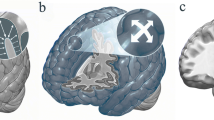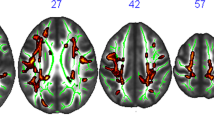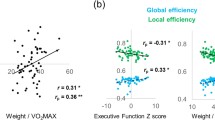Abstract
In the first century, ce, the Roman satirist Juneval famously observed Orandum est, ut sit mens sana in corpore sano, or “A sound mind in a sound body is something to be prayed for.” This implicit link between mental and physical health, also paralleled by Eastern philosophies and practices such as tai chi, has survived the millennia since Juneval and his contemporaries. More recently, controlled examinations of the effects of physical fitness on cognitive performance have shown that improving cardiovascular fitness (CVF) can help to reduce the deleterious effects of age on cognition and brain structure. Thus, as we age, it may well be the case that a sound mind is a natural concomitant of a sound body. Numerous cross-sectional and longitudinal studies have examined the effects of aerobic exercise on cognitive performance in aging humans since earlier studies, which found that physically fit older adults performed better on simple cognitive tasks than their less-fit counterparts. This base of knowledge recently has been furthered through examinations of cortical structure (Colcombe et al., 2003) and neurocognitive function in aging humans via functional and structural magnetic resonance imaging techniques. In this manuscript, we will briefly review some of our recent research on the effects of CVF on brain function, structure, and behavior in older adults. We will then outline some of our current and future directions in this area.
Similar content being viewed by others
References
Barcelo F., Suwanzono S., and Knight R. T. (2000) Prefrontal modulation of visual processing in humans. Nat. Neurosci. 3(4), 399–403.
Baron A. and Mattila W. R. (1989) Response slowing of older adults: effects of time-contingencies on single and dual-task performances. Psychol. Aging 4, 66–72.
Berchtold N. C., Kesslak J. P., Pike C. J., Aldard P. A., and Cotman C. W. (2001) Estrogen and exercise interact to regulate brain derived neurotrophin factor mRNA transcription and protein expression in the rat hippocampus. Eur. J. Neurosci. 14(12), 1992–2002.
Botvinick M., Nystrom L. E., Fissel K., Carter C., and Cohen J. D. (1999) Conflict monitoring versus selection-foraction in anterior cingulate cortex. Nature, 402, 179–181.
Blomstrand E., Perrett D., Parry-Billings M., and Newsholme E. A. (1989) Effect of sustained exercise on plasma amino acid concentrations and on 5-hydroxytryptamine metabolism in six different brain regions in the rat. Acta Physiol. Scand. 136(3), 473–481.
Cabeza, R. (2002) Hemispheric asymmetry reduction in old adults: The HAROLD model. Psychol. and Aging, 17, 85–100.
Cameron H. A. and McKay R. D. (1999) Restoring production of hippocampal neurons in old age. Nat. Neurosci. 2(10), 894–897.
Carro E., Trejo L. J., Busiguina S., and Torres Aleman I. (2001) Circulating insulin-like growth factor 1 mediates the protective effects of physical exercise against brain insults of different etiology and anatomy. J. Neurosci. 21, 5678–5684.
Colcombe S. J. and Kramer A. F. (2003) Fitness effects on the cognitive function of older adults: a meta-analytic study. Psychol. Sci. 14(2), 125–130.
Colcombe S. J., Erickson K., I., Raz N., Webb A. G., Cohen N. J., McAuley E., and Kramer A. F. (2003) Aerobic fitness reduces brain tissue loss in aging humans. J. Gerontol. A. Biol. Sci. Med. Sci. 53(2), 176–180.
Colcombe S. J., Kramer A. F., Erickson K. I., Scalf P., McAuley E., Cohen N. J., et al. (2004) Cardiovascular fitness, cortical plasticity, and aging. Proc. Natl. Acad. Sci. USA 101, 3316–3321.
Cotman C. W. and Berchtold N. C. (2002) Exercise: a behavioral intervention to enhance brain health and plasticity. Trends Neurosci. 25, 295–301.
Etnier J. R., Salazar W., Landers D. M., Petruzzello S. J., Han M. and Nowell P. (1997) The influence of physical fitness and exercise upon cognitive functioning: a meta-analysis. J. Sport Exercise Psychol. 19, 249–277.
Godfrey R. J., Madgwick Z., and Whyte G. P. (2003) The exercise-induced growth hormone response in athletes. Sports Med. 33(8), 599–613.
Kramer A. F., Hahn S., Cohen N. J., Banich M. T., McAuley E., Harrison C. R., et al. (1999a) Ageing, fitness and neurocognitive function. Nature 400, 418–419.
Kramer A. F., Hahn S., and Gopher D. (1999b) Task coordination and aging: explorations of executive control processes in the task-switching paradigm. Acta Psychol. 101, 339–378.
Kramer A. F., Larish J., Weber T., and Bardell L. (1999c) Training for executive control: task coordination strategies and aging. In Gopher D. and Koriat A., eds., Atten. Perform. XVII. MIT Press, Cambridge, MA.
Kramer A., Humphrey D., Larish J., Logan G., and Strayer D. (1994) Aging and inhibition: beyond a unitary view of inhibitory processing in attention. Psychol. Aging 9, 491–512.
Kramer A. F., Larish J., and Strayer D. L. (1995) Training for attentional control in dual-task settings: a comparison of young and old adults. J. Appl. Exper. Psychol. 1, 50–76.
Masunaga H. and Horn J. (2002) Expertise and age-related changes in components of intelligence. Psychol. Aging 16, 293–311.
Neeper S. A., Gomez-Pinilla F., Choi J., and Cotman C. (1995) Exercise and brain neurotrophins. Nature 373, 109.
O’Sullivan M., Jones D. K., Summers P. E., Morris R. G., Williams S. C. R., and Markus H. S. (2001) Evidence for cortical “disconnection” as a mechanism of age-related cognitive decline. Neurology 57, 632–638.
Salthouse T. A. (1984) Effects of age and skill in typing. J. Exp. Psychol. Gen. 113, 345–371.
Scialfa C. T., Jenkins L., Hamaluk E., and Skaloud P. (2000) Aging and the development of automaticity in conjunction search. J. Gerontol. B. Psychol. Sci. Soc. Sci. 55, 7–46.
West R. L. (1996) An application of prefrontal cortex function theory to cognitive aging. Psychol. Bull. 120, 272–292.
Yasuno F., Suhara T., Nakayama T., Ichimiya T., Okubo Y., Takano A., et al. (2003) Inhibitory effect of hippocampal 5-HT1A receptors on human explicit memory. Am. J. Psychiatry 160(2), 334–340.
Author information
Authors and Affiliations
Corresponding author
Rights and permissions
About this article
Cite this article
Colcombe, S.J., Kramer, A.F., McAuley, E. et al. Neurocognitive aging and cardiovascular fitness. J Mol Neurosci 24, 9–14 (2004). https://doi.org/10.1385/JMN:24:1:009
Issue Date:
DOI: https://doi.org/10.1385/JMN:24:1:009




